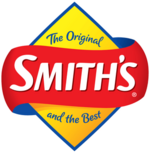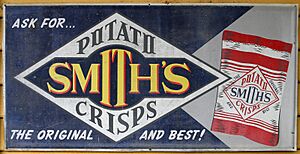The Smith's Snackfood Company facts for kids
 |
|
| Proprietary company | |
| Industry | Food |
| Founded | 1920 in Cricklewood, England (UK branch). 13 May 1932 (Australia branch). |
| Founders |
|
| Headquarters |
,
Australia
|
|
Area served
|
Australia United Kingdom |
| Products | Snack foods, potato chips |
| Parent | PepsiCo |
The Smith's Snackfood Company is a well-known brand that makes yummy snacks, especially potato crisps (or chips!). It started in the United Kingdom and later in Australia. Today, it's owned by a big American company called PepsiCo.
The company began in 1920 in the UK. Two friends, Frank Smith and Jim Viney, started it. They sold plain potato crisps with a tiny twist of salt in a paper bag. You could sprinkle the salt on yourself! This idea was very popular in London.
Smith's was the top crisp brand in the UK until the 1960s. Then, another company, Golden Wonder, became popular with Cheese & Onion crisps. Smith's fought back by creating the famous Salt & Vinegar flavour in 1967.
After its success in the UK, Frank Smith started the company in Australia in 1932. Over the years, both the UK and Australian parts of Smith's were owned by different companies. But eventually, PepsiCo bought both of them, bringing the Smith's brand back together. In the UK, Smith's is now part of the Walkers brand, but in Australia, Smith's is still the main name.
Contents
Smith's in the United Kingdom
Smith's Potato Crisps was started by Frank Smith and Jim Viney in the UK after World War I. Frank Smith used to manage a food business that sold crisps. He decided to make his own.
He turned some garages in London into a crisp factory. By 1920, he had 12 employees and was making half a million packets of crisps every week! Frank's clever idea was to sell plain crisps with a small blue sachet of salt. People could add the salt themselves.
In 1927, Smith's moved to a bigger factory. By 1929, they had seven factories across the UK. By 1934, Smith's made 95% of all crisps sold in Britain. During World War II, Smith's crisps were even sent to soldiers.
In the 1950s, a character from a BBC radio show, Doris Archer, even suggested using "delicious Smith's potato crisps" in recipes! By 1956, the company was making 10 million packets every week.
In the 1960s, Smith's bought other snack companies like Tudor Crisps. When their rival, Golden Wonder, launched Cheese & Onion crisps, Smith's created Salt & Vinegar. This started a "flavour war" that lasted for 20 years!
In 1966, a big American food company, General Mills, bought Smith's. Smith's even had a "Do The Crunch" ad campaign. A young Phil Collins, who later became a famous musician, toured the UK teaching people a "crunch dance."
Smith's also launched Monster Munch in 1977, which were big, monster-shaped snacks. In 1978, Smith's was sold to a British biscuit company called Associated Biscuits.
Later, in 1989, PepsiCo bought Smith's. PepsiCo decided to focus on another British brand, Walkers. Many products that used to be Smith's, like Quavers, were then sold under the Walkers name.
Popular Smith's Products in the UK
- Chipsticks – Long, thin, crunchy snacks that taste like salt and vinegar.
- Frazzles – Bacon-flavoured snacks shaped like bacon strips.
- Bacon Fries – Small, crunchy snacks with a bacon flavour.
- Scampi Fries – Crunchy snacks with a scampi (a type of seafood) flavour.
- Funyuns – Crunchy rings that taste like onions.
- Snaps – Crispy potato snacks with a spicy tomato flavour.
- Smith's Crisps – Classic potato crisps in Ready Salted, Salt & Vinegar, or Cheese & Onion flavours.
Smith's in Australia
Frank Smith also started a Smith's company in Australia. Smith's Crisps were first made in Australia in 1931 in Sydney. They were cooked in 20 gas-fired pots, packed by hand, and delivered by Nestle vans.
Early Smith's crisps in Australia also came with "twist of salt" sachets. In 1932, the company faced problems because of the Great Depression. But it was quickly restarted as Smith's Potato Crisps (Australia).
After World War II, the company grew fast. They started using continuous cooking machines instead of individual pots. In 1961, Smith's introduced its first flavoured chip in Australia: Chicken! This flavour became very popular.
Other flavours like Original (Pre-Salted) and Salt & Vinegar were also released. In the 1970s, Barbecue flavour was added for crinkle-cut chips. In the 1980s, Cheese & Onion joined the list. These five flavours are still the main ones today.
In the late 1980s, Smith's introduced a famous advertising character called Gobbledok. It was a chip-loving alien, a bit like E.T.!
In 1998, PepsiCo bought Smith's Snackfood Company in Australia. PepsiCo already owned Frito-Lay, another big snack company. To make sure there was fair competition, PepsiCo had to sell some brands and factories. These brands, like CC's, Cheezels, Thins, and Samboy, were sold to a company called Snack Brands Australia.
Even though Australians usually say "chips," Smith's called their product "crisps" until 2003. Now, they are called Smith's Chips.
Product Recalls
Sometimes, Smith's products have been recalled (taken back from stores) for safety reasons:
- In 2007, 2008, and 2009, Crinkle Cut chips were recalled because small pieces of rubber were found in some packets.
- In 2022 and 2023, Crinkle Cut chips were recalled again because plastic pieces were found in packets.
Product Advertising
In 2016, Smith's Snackfood Company was fined for misleading advertising. They had a logo on their Sakata Paws Pizza Supreme Rice Snacks that said "Meets School Canteen Guidelines" with a picture of a sandwich and an apple. However, the product only met the "Amber" (medium healthiness) guidelines, and this was written in tiny print on the back. Smith's has since removed this logo.
Popular Smith's Products in Australia
- Burger Rings – Snacks that taste like hamburgers.
- Cheetos – Puffy snacks with cheese or spicy flavours.
- Cool Pak Popcorn – Ready-to-eat popcorn.
- Doritos – Crunchy corn chips.
- Grain Waves – Chips made from whole grains.
- Maxx – Thick-cut chips with various flavours.
- Nobby's – Different kinds of nuts.
- Parker's – Pretzels in many shapes and flavours.
- Red Rock Deli – Fancy, thick-sliced potato chips.
- Sakata – Crispy rice crackers.
- Smith's Crinkle Cut – Potato chips with wavy edges.
- Smith's Popped – Light, air-popped potato snacks.
- Lay's Stax – Stackable potato chips, similar to Pringles.
- Smith's Thinly Cut – Very thin potato chips.
- Twisties – Twisted, puffy snacks with cheese or chicken flavour.
Past Products in the UK & Australia
- Bats – Bat-shaped snacks from the 1970s.
- Bones – Bone-shaped snacks from the 1970s.
- Cheezers – Cheese-flavoured corn puffs.
- Chinese Quavers – Spicy beef flavour.
- Chipitos – Toasted cheese puffs.
- Claws – Claw-shaped snacks from the 1970s.
- Crispy Tubes – Tube-shaped snacks from the 1980s.
- Fangs – Fang-shaped snacks from the 1970s.
- French Fries – Small potato straws, now made by Walkers.
- Jackets – Crisps made with potato skin left on, from the mid-1980s.
- Maize Pops – Toffee-coated popped corn.
- Monster Munch – Now made by Walkers.
- OnYums – Onion-flavoured rings.
- Quavers – Now made by Walkers.
- Ribs – Rib-shaped snacks from the 1970s.
- Ruffles – Crinkle-cut potato chips.
- Smiths Salt 'n' Shake – Now made by Walkers.
- Squares – Square-shaped potato crisps, now made by Walkers.
- Sunbites – Wholegrain chips.
- Thins – Thinly sliced potato chips, now made by Snack Brands Australia.
- Tuba Loops – Tube-shaped potato snacks.
- Twists – Twisted snacks from the 1970s.
- Wafflers – Bacon-flavoured waffles.
See also



